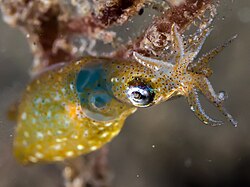| Idiosepius pygmaeus | |
|---|---|
 | |
| Adult | |
 | |
| Hatchlings (c. 2 mm long) stained with phosphotungstic acid (left) and Lugol's iodine (right) | |
| Scientific classification | |
| Kingdom: | Animalia |
| Phylum: | Mollusca |
| Class: | Cephalopoda |
| Order: | Idiosepida |
| Family: | Idiosepiidae |
| Genus: | Idiosepius |
| Species: | I. pygmaeus |
| Binomial name | |
| Idiosepius pygmaeus Steenstrup, 1881 [2] | |
Idiosepius pygmaeus, also known as the two-toned pygmy squid or tropical pygmy squid, is a species of bobtail squid native to the Indo-Pacific. It resides in the South China Sea, Japan, Philippines, Palau, Indonesia, the Northern Mariana Islands, as well as northern and northeastern Australia. The squid traditionally inhabits shallow, inshore waters. [3] [4]
Contents
I. pygmaeus weighs 0.00033 g upon hatching and increases in weight to 0.175 g as it reaches maturity in 50 days (1260 degree days). The squid prefers waters at a temperature of 25.2 °C. Growth rate has been calculated as 12.55 and physiological growth rate as 0.498. [5]
I. pygmaeus grows to a mantle length of 20 mm. [3]
This species eats glass shrimp ( Acetes sibogae australis) in the laboratory. [6]
The type specimen was collected in the South China Sea ( 04°20′N107°20′E / 4.333°N 107.333°E ) and is deposited at the Zoologisk Museum of Kobenhavns Universitet in Copenhagen. [7]
